Recently, as I was browsing through one of my social media feeds, I came across a post from an individual who was new to the board gaming hobby. She was wondering what all the talk of “Kickstarter” was about. Thinking about how to answer that question took me back to a time where I had found myself asking the same question.
At the time I was just a fledgling review writer. Having written reviews for every game in my meager collection and the few other titles I’d played enough times to feel like I could write about them well, I was desperate for some new content. I reasoned that the easiest way for an unestablished reviewer to gain access to new content would be to find creators that were desperate for coverage. That eventually led me to Kickstarter. As I began reaching out to the various campaign creators on that platform, I couldn’t help but become curious about what it was and how it worked.

The lessons I learned and things I discovered were all brought about by trial and error. I didn’t have a guide that could walk me through it and make sense of the landscape. When I encountered new concepts or unfamiliar terminology, I had to ask a lot of questions in order to wrap my head around what was going on.
As I sat there thinking about how to answer that social media post, I decided that I didn’t want someone else to have to go through the process that I went through. I decided that what was needed was a primer. And here we are. If you’re reading this, I hope that you find this information useful.
Frequently Asked Questions:
What is Kickstarter?
Kickstarter is just one of many “crowdfunding” platforms. It is a website that provides the tools needed for creators to try to entice potential consumers to invest in their passion projects in order to bring those projects to life.
When you’re asking “What is Kickstarter?”, the question you might be asking is “What is crowdfunding?” Crowdfunding allows a creator to fund their project by dividing the cost between a large number of end-users instead of having to fund the project themselves. In the case of a Kickstarted board game, a creator can appeal to the players directly instead of having to go the traditional “wine and dine a publisher” route to see their creation come to fruition. If enough players agree that the game presented to them is one they’d like to see become a reality, and agree to bear a portion of the cost to produce it, then the project will fund and, theoretically, the product will become an actual thing (See Am I guaranteed a return on my investment?, below).
As a board gamer, I use Kickstarter almost exclusively to search for projects in the tabletop gaming realm, but the platform is used for all sorts of other things, too: technology, fashion, music, books, film, etc. It’s even been used to fund ridiculous projects like this one for potato salad. Games, however, are Kickstarter’s bread and butter comprising the largest segment by campaign and dollar amount. Kickstarter was the platform used to launch the very first crowdfunded tabletop game, Alien Frontiers.
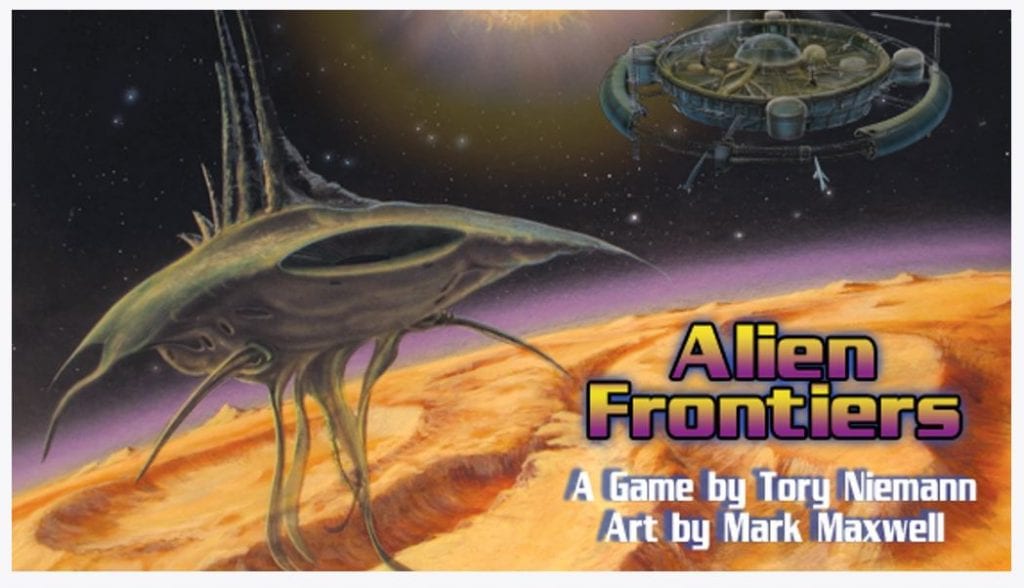
Even though Kickstarter is probably the most well-known crowdfunding platform, there are several others that are enjoying great success as well such as:
Indiegogo: Indiegogo is a crowdfunding platform that’s pretty much exactly like Kickstarter in the types of projects you’ll find there, but it would actually be more proper to say that Kickstarter is pretty much exactly like Indiegogo since Indiegogo launched over a year before Kickstarter did. The primary difference between the two platforms is the way that funds are released. Kickstarter only releases funds to a project creator once the campaign is finished and only if it has reached its goal, while Indiegogo has the option to receive your funds as they come in. Also, unlike Kickstarter, Indiegogo allows the creator the option to receive their funds even if their funding goal isn’t met.
Indiegogo was famously used to provide the funding for season 3 of Wil Wheaton’s ‘Tabletop’ series.
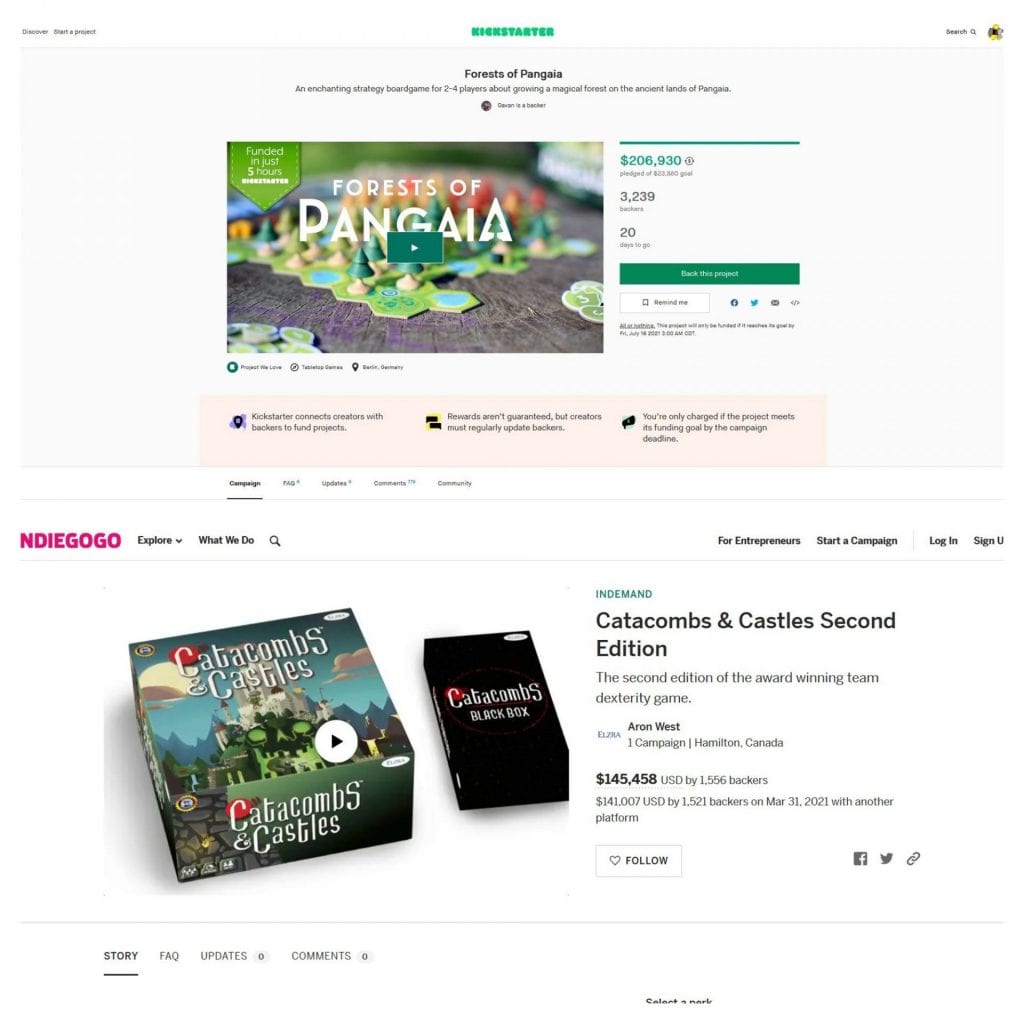
Gamefound: Gamefound originally began its life as a pledge manager (See Pledge Manager, below) platform, but recently moved into the crowdfunding arena with the launch of the ISS Vanguard campaign in December of 2020. It has been designed from the ground up exclusively for tabletop games. As such, the interface is vastly different from the ones you’ll find on Kickstarter and Indiegogo (whose interfaces are very similar). While not as popular as those others, it is steadily gaining a following and has even enticed some big name companies like Portal Games with their Robinson Crusoe Collector’s Edition campaign.
GoFundMe: GoFundMe is a different kind of crowdfunding platform. Most crowdfunding platforms treat campaign participants as investors; the participants collectively provide the money needed to bring the project to life with the understanding that they will receive something in return. GoFundMe operates purely on charitable donations. Any money that you give to a project is given without the expectation that you’ll receive something for doing so. As such, it has become the platform of choice for people having to deal with life emergencies such as unexpected medical bills or recovering from a house fire.
What does it mean to “back” a project?
If you come across a project that you believe should be brought to life and decide to provide financial support for it, then you have become a “backer”. You’ve essentially got the project’s back.
What is a “Funding Goal”?
When someone creates a project, they will need to calculate the monetary amount that is required in order for the product to be produced. This is their funding goal.
What is a “Pledge”?
A pledge is the monetary amount that you have agreed to pay in order to help bring the project to life. With most platforms, this means your pledge is a pre-payment for a specific item or items (See Reward Level, below). Whether that monetary amount is deducted from your bank account immediately or at a later time depends entirely upon the platform that the project was created on.
What is a “Reward Level”?
On platforms like Kickstarter, Indiegogo, and Gamefound, you are treated as an investor. The project creator will promise to provide you with X if you pay Y amount. The X can change in regards to the Y. For instance, if you pay $32, then you will receive a copy of the game. If you pay $60, you will receive two copies of the game at a $4 discount. For ease of use and organization, each of these agreements is assigned a unique name. For instance, the first example I gave might be called “Single Game Pledge” and the second might be called “Multi-game Pledge”. These different options are collectively known as reward levels (or reward tiers).
What is a “Stretch Goal”?
Sometimes the funding goal is the bare minimum needed to produce whatever the project is. However, the project creator has determined that with just a little more, the end product can be souped up and made even better. With just a little bit more beyond that, even more can be done. Each of these “beyond the funding goal” increments is called a “stretch goal”.

In the world of board gaming, common stretch goals include things such as thicker card stock, linen-finished cards, upgrading cardboard punch out resources to 3D resources, upgrading cardboard currency to metal coins, etc. None of these are required to be able to play the game, but each one of them makes the final product just a little fancier.
What is an “Add-On”?
Sometimes a project creator has something else they’ve already created that is outside the scope of the current campaign that they’ll sell you if you tack a few extra dollars onto your pledge. These additional purchases are called “add ons”. On the Kickstarter platform, for instance, a game creator may offer to sell you one of their previous titles by adding X amount to your pledge. When you go to your current pledge, there is a blank space for you to type in a custom pledge amount. You would simply add the cost of the reward level you have selected plus the cost of any add-ons you would like and then enter that amount. This becomes your new pledge.
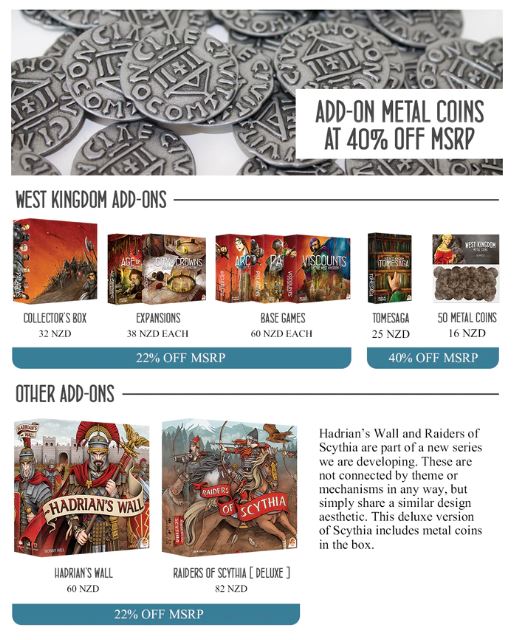
What is a “Pledge Manager”?
A pledge manager is a separate company from the crowdfunding platform that creators will sometimes use to handle the logistics that the tools provided by the crowdfunding platform may not address: collecting shipping, selling add-ons, taking pre-orders, etc.
As an example of how a pledge manager comes in handy, consider the Kickstarter campaign for Paladins of the West Kingdom: City of Crowns. Listed in the “Reward Levels And Optional Add-Ons” section are 3 distinct tier levels and 7 different add-on items. Sure, the project creator could have created a different reward tier for each separate permutation of how a backer might want to mix and match everything. That would be at least 25 different tier levels (each reward tier by itself and each reward tier with a different add-on), but that doesn’t even account for people who might wish to buy multiples of the same add-on. Instead, it’s much easier to list the price for each add-on, allow the customer to do the math themselves, and then use the pledge manager to ask them what they were wishing to purchase in addition to the reward tier they selected.
Some popular pledge managers that you may come across are BackerKit, CrowdOx, and Gamefound.
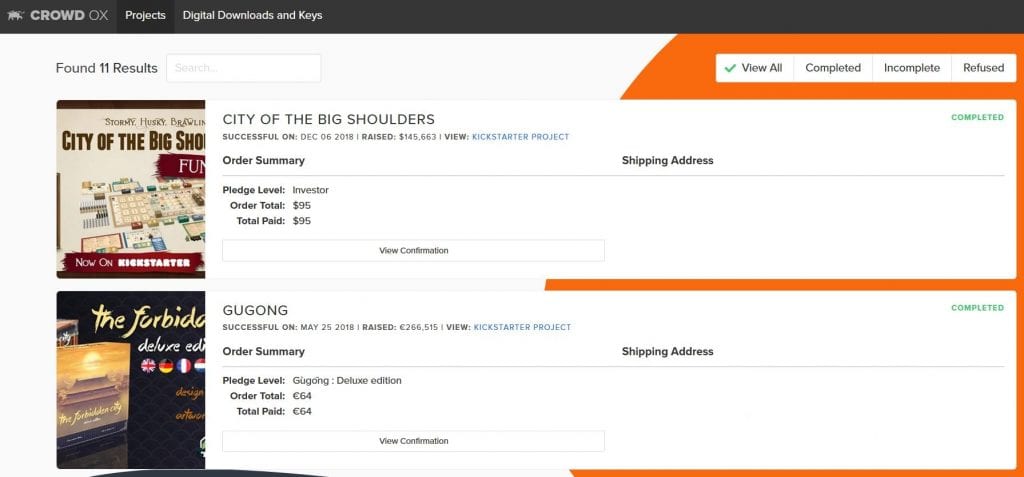
Am I guaranteed a return on my investment?
Unfortunately, no. While investing in a project is usually safe, there is always risk involved. Unforeseen circumstances can always arise (such as a global pandemic!) and that can really mess up timetables causing delays in project fulfillment. If you’re lucky, the project will eventually deliver even if it’s just very, very late. Sometimes, though (not often), unscrupulous people may just take the money and run. In my time on Kickstarter, I have personally backed 81 projects and only a single one of those has never delivered (and I suspect that it never will).
How does shipping work?
There is no hard and fast rule for how a project creator deals with shipping. Some will try to average what they believe shipping will be ahead of time and factor that into the funding goal, some will provide you with a chart showing the shipping required to send to different destinations and leave it up to you to add that to your reward level on your own, others will ask you for the shipping in the pledge manager. Typically, though, the further you are away from wherever the product is being assembled, the more it’s going to cost you in shipping costs.
How does payment work?
Each platform usually requires a valid credit card number to be provided at the time that you select your reward level and make your pledge. Some may offer other non-traditional payment options such as PayPal. The types of payment accepted depend entirely upon the crowdfunding platform.
When and how payment is collected depends entirely upon the platform and how the creator uses it. As discussed previously, Kickstarter only attempts to collect your pledge when the campaign ends and only if the campaign met its funding goal. Other platforms may allow the creator to collect funds earlier than that.
In the case of Kickstarter, you are given a 7 day grace period from the moment the campaign ends if it attempts to collect your pledge and cannot for some reason (wrong credit card information, not enough funds, etc.). I cannot speak to any of the others as I have never used them.
Features
Comments section
Each campaign will typically have a comments section where the campaign backers can interact with each other and sometimes even interact with the campaign creator or some official representative for the campaign. Backers can share their excitement, offer suggestions for stretch goals, ask questions, etc. A more active comments section (especially if the creators are involved) will generally result in a much better final product.
Updates
Updates are the creator’s way of communicating with their backers concerning the current status of the project and any news relevant to the project. Communication is important, especially if there are delays, and updates can also be used as a way for a designer to share insights into the design process or features they’re working on.
A good example of this is Frosthaven. Every 2 weeks, Isaac provides an update on the current status of the project even if the update isn’t filled with good news. His constant communication lets the backers know that he’s still working diligently on getting the product into their hands.
FAQs
A project creator can try their best to anticipate every question that might be asked and provide all of that information up front. Invariably, though, they will find themselves fielding the same questions time and time again. The FAQ section of the crowdfunding page gives the creator a place to address these issues and provides their backers with a quick and easy way to see if their questions have already been answered.

Backed Projects History
Being able to see which projects you’ve backed and when can be useful if you’re trying to budget for future purchases, trying to analyze your spending practices, or have simply forgotten which projects you’ve backed and haven’t received yet. It’s also a way for you to quickly navigate to one of these projects if need be.
Tips and Tricks
Backing at $1 for access to pledge manager/comments
This is a tip specific to Kickstarter although it may apply to other platforms as well. If you’re following a campaign but are still on the fence about it, you can back it at the $1 level. This gives you access to updates that may be viewable by backers only and also the comments section so that you can follow along until you make up your mind. Also, if you’re interested in a campaign but don’t currently have the funds to back it but know you will in the future and if that campaign is using a pledge manager, then backing the campaign for $1 will give you access to that pledge manager. This will allow you to add a copy of the game at a future date.
Group pledges to defray shipping costs
I mentioned shipping costs earlier. Oftentimes a campaign will lose backers because of these costs. Some enterprising backers, though, will sometimes band together and order multiple copies of the product in order to defray the shipping costs. This is called a “group pledge”. Sometimes the campaign offers this as a reward level (which is becoming a popular thing for creators to do) and sometimes it’s handled between the backers themselves. There’s even a website called CrowdFinder that has emerged to make finding or setting up group pledges even easier.
What are some good resources if I decide I would like to run my own crowdfunding campaign?
Here at Meeple Mountain, we have written several articles exploring the process of creating and running a successful Kickstarter campaign. The lessons learned therein can be applied to pretty much any crowdfunding platform and any crowdfunded project, though.
In his interview with resident writer and game designer Gary Chavez, my fellow writer Andrew Holmes speaks with Gary about his design process and his experiences running a successful Kickstarter campaign.
In another interview with two of our other writers Logan Gianini and Robert Crowter-Jones, Andrew bends their ears for their sage Kickstarter advice.
Guest author, Nalin Chuapetcharasopon, wrote an article that provides some excellent Kickstarter marketing advice.
Our Editor In Chief, Andy Matthews, wrote about the Top 7 things that make a really great Kickstarter campaign.
But perhaps the most well-known wellspring of Kickstarter wisdom can be found by reading Jamey Stegmaier’s (creator of Scythe and owner of publisher Stonemaier Games) Kickstarter Lessons.


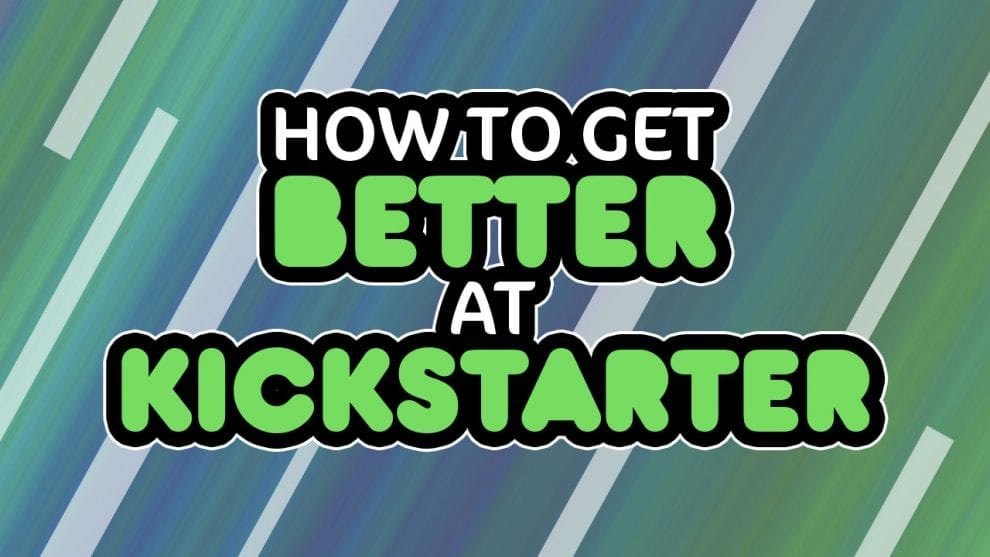



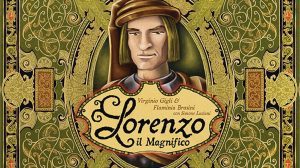




Add Comment